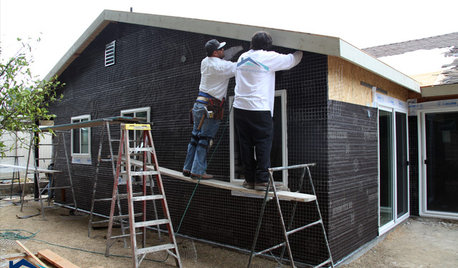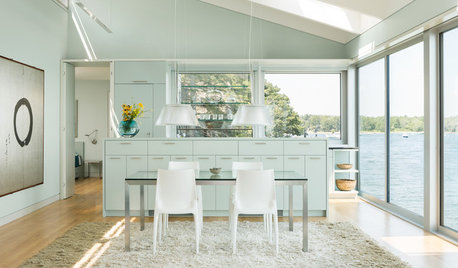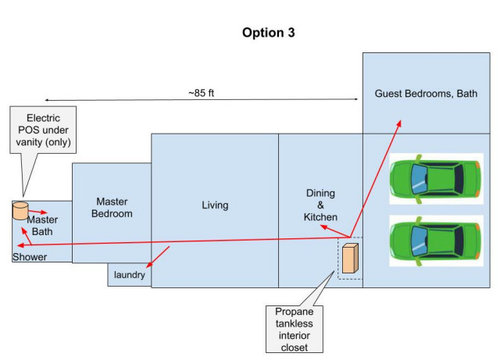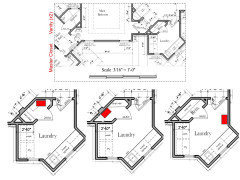Help with Hot Water Heater Locations and Wait Times
HU-528228756
2 years ago
last modified: 2 years ago
Featured Answer
Sort by:Oldest
Comments (36)
Mark Bischak, Architect
2 years agoJake The Wonderdog
2 years agolast modified: 2 years agoRelated Discussions
We have no hot water: help decide what water heater system asap.
Comments (9)I installed it all and plumbed it myself - Not a really difficult job . . . . maybe 3 on a scale of 5 The collector panel was $1K, the tanks were $600 for the pair, the circulator pump was $100, the differential controller was $200 and about another $300 for copper piping, valves, flowmeter and an analog temp guage. $2200 for the total system, give or take $100. We had no hot water heater to begin with, so we would have had to spend $300 anyway, so take away the $300 and the $400 in Tax rebates and the system actually cost us $1500 - I got $300 off my federal income tax and another $100 from the state My 'break even point' is about 3 to 4 years - It would be higher if I had paid another $1500 to $2K for a professional installation We're remodeling an old farmhouse, so we've never lived here with anything but the solar heat but the tag on the side of one of the water heaters says it costs $400 per year to run - It's a very high efficiency unit with 3 inches of polyfoam insulation, so a lesser water heater would cost more to operate. $500 to $600 per year is probably an average cost for domestic water heating per year for a family of four I REALLY don't understand why there isn't a larger push from the government on solar water heating. Unlike solar electric, or hybrid cars, this technology is pretty well perfected right now and the payback is much shorter than for just about any other 'green' energy source. It can be used in most places in the United States. The outside temp isn't a big factor in how well it works . . . . it depends more on how many sunny days you have If more houses had solar domestic hot water systems, we could make a huge dent in the total energy use of the country and just think of how much less fossil fuel we would consume Don...See MoreMinimizing hot water wait time - PEX home run or trunk and branch
Comments (3)I doubt very seriously if your plumbing inspector will allow you to discharge the water heater TPRV into the shower pan. If someone happened to be in the shower when the valve opened their feet would be scalded. That water heater is on an outside wall. The preferred method would be to discharge both the TPRV & the pan outdoors through the wall. Also, you are just arbitrarially assuming 1/2" is the correct size of the PEX lines, that is not correct. I strongly suggest you download the free PDF Zurn PEX Installation guide. http://0323c7c.netsolhost.com/docs/PEXDesApplGuide.pdf...See MoreReplacing 50-gallon electric hot water heater - need more hot water!
Comments (3)What is all the hot water needed for? A gas heater doesn't have to be in a well ventilated space because waste gases must be vented to the outdoors. It just needs source air and that's very easily done. Running a gas line is never a structural issue...it's a money issue. If two 50 gal units is a small fortune to operate...wouldn't one be 1/2 a small fortune? Still sound like a lot. I mean it's not like the second unit would cost 2x,4x,10x more than the first unit. That is kind of the deal if you want lots and lots of hot water on demand...it costs money. Solar can get you lots of pretty cheap hot water, at least DIY. The units you buy seem kind of expensive to me for what they are....See MoreNeed help urgent - Water leak by the hot water heater
Comments (12)Thanks. I am assuming given that I am not going to be using the air conditioner for 6 more months, I can drain it out and should be good? Wrong, during heating condensate is also produced. It needs to be fixed before both the cooling and heating season. I also suspect the condensate pump considering it is full, it will normally empty out once the float activates the pump but clearly there is something wrong with yours. The pump may have just quit working and need replaced. They are not that expensive....See MoreCharles Ross Homes
2 years agoJake The Wonderdog
2 years agopima74
2 years agoCharles Ross Homes
2 years agoDavid Cary
2 years agoVerbo
2 years agoCharles Ross Homes
2 years agokaseki
2 years agoCharles Ross Homes
2 years agoDavid Cary
2 years agoCharles Ross Homes
2 years agochisue
2 years agolast modified: 2 years agoHU-528228756
2 years agoShola Akins
2 years agoDavid Cary
2 years agolast modified: 2 years agoCharles Ross Homes
2 years agoremodeling1840
2 years agoMindy Thomas
2 years agoHU-528228756
2 years agolast modified: 2 years agoMindy Thomas
2 years agoHU-528228756
2 years agopima74
2 years agoJake The Wonderdog
2 years agokaseki
2 years agolast modified: 2 years agoCharles Ross Homes
2 years agoJake The Wonderdog
2 years agoCharles Ross Homes
2 years agokaseki
2 years agoHU-528228756
2 years agoJake The Wonderdog
2 years agoCharles Ross Homes
2 years agoJake The Wonderdog
2 years ago
Related Stories

GREAT HOME PROJECTSHow to Switch to a Tankless Water Heater
New project for a new year: Swap your conventional heater for an energy-saving model — and don’t be fooled by misinformation
Full Story
GREAT HOME PROJECTSHow to Add a Solar Water Heater
Lower energy bills without a major renovation by putting the sun to work heating your home’s water
Full Story
INDUSTRY RESEARCHData Watch: As Labor Shortages Grow, So Do Project Wait Times
Houzz research finds average project wait times ranging from 3.5 weeks in St. Louis to 13.2 weeks in Boston
Full Story
CONTAINER GARDENSContainer Garden Basics: How and When to Water Potted Plants
Confused about soil moisture, the best time to water and what watering device to use? This guide can help
Full Story
PETSHow to Help Your Dog Be a Good Neighbor
Good fences certainly help, but be sure to introduce your pup to the neighbors and check in from time to time
Full Story
REMODELING GUIDESWisdom to Help Your Relationship Survive a Remodel
Spend less time patching up partnerships and more time spackling and sanding with this insight from a Houzz remodeling survey
Full Story
HOUZZ TOURSHouzz Tour: Battling the Tides Results in a Wondrous House on the Water
A complex construction effort pays off big-time with unobstructed views of Blue Hill Bay in Maine
Full Story
GREEN DECORATINGEasy Green: Big and Small Ways to Be More Water-Wise at Home
These 20 tips can help us all make the best use of a precious resource. How do you save water in summer?
Full Story
FEATURESOscar Time: Does Your House Have Star Quality?
Private homes are a hot commodity in the movie industry. See how one landed a role in ‘La La Land’
Full Story
SAVING WATER11 Ways to Save Water at Home
Whether you live in a drought-stricken area or just want to help preserve a precious resource, here are things you can do to use less water
Full Story









Charles Ross Homes